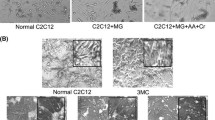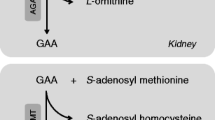Abstract
The creatine/creatine kinase (CK) system plays a key role in cellular energy buffering and transport. In vertebrates, CK has four isoforms expressed in a tissue-specific manner. In the process of creatine biosynthesis several other important metabolites are formed. The anticancer effect of creatine had been reported in the past, and recent literature has reported low creatine content in several types of malignant cells. Furthermore, creatine can protect cardiac mitochondria from the deleterious effects of some anticancer compounds. Previous work from our laboratory showed progressive decrease of phosphocreatine, creatine and CK upon transformation of skeletal muscle into sarcoma. It was convincingly demonstrated that prominent expression of creatine-synthesizing enzymes l-arginine: glycine amidinotransferase and N-guanidinoacetate methyltransferase occurs in sarcoma, Ehrlich ascites carcinoma and sarcoma 180 cells; whereas, both these enzymes are virtually undetectable in skeletal muscle. Creatine transporter also remained unaltered in malignant cells. The anticancer effect of methylglyoxal had been known for a long time. The present work shows that this anticancer effect of methylglyoxal is significantly augmented in presence of creatine. On creatine supplementation the effect of methylglyoxal plus ascorbic acid was further augmented and there was no visible sign of tumor. Moreover, creatine and CK, which were very low in sarcoma tissue, were significantly elevated with the concomitant regression of tumor.





Similar content being viewed by others
Abbreviations
- AGAT:
-
l-Arginine: glycine amidinotransferase
- CK:
-
Creatine kinase
- EAC:
-
Ehrlich ascites carcinoma
- GAMT:
-
N-guanidinoacetate methyltransferase
- MCK:
-
Muscle-specific cytosolic CK
- BCK:
-
Brain-specific cytosolic CK
- MitCK:
-
Mitochondrial CK
- sMitCK:
-
Sarcomeric MitCK
- uMitCK:
-
Ubiquitous MitCK
- MPT:
-
Mitochondrial permeability transition
References
Apple MA, Greenberg DM (1968) Arrest of cancer in mice by therapy with normal metabolites. II. Indefinite survirors among mice treated with mixtures of 2-oxopropanal (NSC-79019) and 2, 3-dihydroxypropanal (NSC67934). Cancer Chemother Rep 52:687–696
Balasubramani M, Day BW, Schoen RE, Getzenberg RH (2006) Altered expression and localization of creatine kinase B, heterogeneous nuclear ribonucleoprotein F, and high mobility group box 1 protein in the nuclear matrix associated with colon cancer. Cancer Res 66:763–769
Bera S, Wallimann T, Ray S, Ray M (2008) Enzymes of creatine biosynthesis, arginine and methionine metabolism in normal and malignant cells. FEBS J 275:5899–5909
Brdiczka DG, Zorov DB, Sheu SS (2006) Mitochondrial contact sites: their role in energy metabolism and apoptosis. Biochim Biophys Acta 1762:148–163
Brosnan JT, Brosnan ME (2006) The sulfur-containing amino acids: an overview. J Nutr 136:1636S–1640S
Buford TW, Kreider RB, Stout JR, Greenwood M, Campbell B, Spano M, Ziegenfuss T, Lopez H, Landis J, Antonio J (2007) International Society of Sports Nutrition position stand: creatine supplementation and exercise. J Int Soc Sports Nutr 4:6
Ceddia RB, Sweeney G (2004) Creatine supplementation increases glucose oxidation and AMPK phosphorylation and reduces lactate production in L6 rat skeletal muscle cells. J Physiol 555:409–421
da Silva RP, Nissim I, Brosnan ME, Brosnan JT (2009) Creatine synthesis: hepatic metabolism of guanidinoacetate and creatine in the rat in vitro and in vivo. Am J Physiol Endocrinol Metab 296:E256–E261
Davies NP, Wilson M, Harris LM, Natarajan K, Lateef S, Macpherson L, Sgouros S, Grundy RG, Arvanitis TN, Peet AC (2008) Identification and characterisation of childhood cerebellar tumours by in vivo proton MRS. NMR Biomed 21:908–918
Du J, Suzuki H, Nagase F, Akhand AA, Yokoyama T, Miyata T, Kurokawa K, Nakashima I (2000) Methylglyoxal induces apoptosis in Jurkat leukemia T cells by activating c-Jun N-terminal kinase. J Cell Biochem 77:333–344
Együd LG, Szent-Györgyi A (1968) Cancerostatic action of methylglyoxal. Science 160:1140
Gazdar AF, Zweig MH, Carney DN, Van Steirteghen AC, Baylin SB, Minna JD (1981) Levels of creatine kinase and its BB isoenzyme in lung cancer specimens and cultures. Cancer Res 41:2773–2777
Ghosh A, Bera S, Ghosal S, Ray S, Basu A, Ray M (2011) Differential inhibition/inactivation of mitochondrial complex I implicates its alteration in malignant cells. Biochemistry (Moscow) (in press)
Ghosh M, Talukdar D, Ghosh S, Bhattacharyya N, Ray M, Ray S (2006) In vivo assessment of toxicity and pharmacokinetics of methylglyoxal. Augmentation of the curative effect of methylglyoxal on cancer-bearing mice by ascorbic acid and creatine. Toxicol Appl Pharmacol 212:45–58
Gilbert SF (2009) Ageing and cancer as diseases of epigenesis. J Biosci 34:601–604
Hatano E, Tanaka A, Kanazawa A, Tsuyuki S, Tsunekawa S, Iwata S, Takahashi R, Chance B, Yamaoka Y (2004) Inhibition of tumor necrosis factor-induced apoptosis in transgenic mouse liver expressing creatine kinase. Liver Int 24:384–393
Horska A, Ulug AM, Melhem ER, Filippi CG, Burger PC, Edgar MA, Souweidane MM, Carson BS, Barker PB (2001) Proton magnetic resonance spectroscopy of choroid plexus tumors in children. J Magn Reason Imaging 14:78–82
Jones PA, Gonzalgo ML (1997) Altered DNA methylation and genome instability: a new pathway to cancer? Proc Natl Acad Sci USA 94:2103–2105
Joseph J, Cardesa A, Carreras J (1997) Creatine kinase activity and isoenzymes in lung, colon and liver carcinomas. Br J Cancer 76:600–605
Kerksick C, Harvey T, Stout J, Campbell B, Wilborn C, Kreider R, Kalman D, Ziegenfuss T, Lopez H, Landis J, Ivy JL, Antonio J (2008) International Society of Sports Nutrition position stand: nutrient timing. J Int Soc Sports Nutr 5:17 (erratum in J Int Soc Sports Nutr 5:18)
Kornacker M, Schlattner U, Wallimann T, Verneris MR, Negrin RS, Kornacker B, Staratschek-Jox A, Diehl V, Wolf J (2001) Hodgkin disease-derived cell lines expressing ubiquitous mitochondrial creatine kinase show growth inhibition by cyclocreatine treatment independent of apoptosis. Int J Cancer 94:513–519
Kristensen CA, Askenasy N, Jain RK, Koretsky AP (1999) Creatine and cyclocreatine treatment of human colon adenocarcinoma xenografts: 31P and 1H magnetic resonance spectroscopic studies. Br J Cancer 79:278–285
Kroemer G, Galluzzi L, Brenner C (2007) Mitochondrial membrane permeabilization in cell death. Physiol Rev 87:99–163
Layne E (1957) Sepctrophotometric and turbidimetric methods for measuring proteins. Methods Enzymol 3:447–454
Lehnhardt FG, Bock C, Rohn G, Ernestus RI, Hoehn M (2005) Metabolic differences between primary and recurrent human brain tumors: a 1H NMR spectroscopic investigation. NMR Biomed 18:371–382
Lillie JW, O’Keefe M, Valinski H, Allen Hamlin H, Varban ML, Kaddurah-Daouk R (1993) Cyclocreatine (l-carboxymethyl-2-iminoimidazolidine) inhibits growth of a broad spectrum of cancer cells derived from solid himors. Cancer Res 53:3172–3178
Martínez-Bisbal MC, Celda B (2009) Proton magnetic resonance spectroscopy imaging in the study of human brain cancer. Q J Nucl Med Mol Imaging 53:618–630
Martin KJ, Chen SF, Clark GM, Degen D, Wajima M, Von Hoff DD, Kaddurah-Daouk R (1994) Evaluation of creatine analogues as a new class of anticancer agents using freshly explanted human tumor cells. J Natl Cancer Inst 86:608–613
Meffert G, Gellerich FN, Margreiter R, Wyss M (2005) Elevated creatine kinase activity in primary hepatocellular carcinoma. BMC Gastroenterol 5:9
Miller EE, Evans AE, Cohn M (1993) Inhibition of rate of tumor growth by creatine and cyclocreatine. Proc Natl Acad Sci USA 90:3304–3308
Morris SM Jr (2009) Recent advances in arginine metabolism: roles and regulation of the arginases. Br J Pharmacol 157:922–930
Neumann D, Schlattner U, Wallimann T (2003) A molecular approach to the concerted action of kinases involved in energy homoeostasis. Biochem Soc Trans 31:169–174
O’Gorman E, Beutner G, Dolder M, Koretsky AP, Brdiczka D, Wallimann T (1997) The role of creatine kinase in inhibition of mitochondrial permeability transition. FEBS Lett 414:253–257
Onda T, Uzawa K, Endo Y, Bukawa H, Yokoe H, Shibahara T, Tanzawa H (2006) Ubiquitous mitochondrial creatine kinase downregulated in oral squamous cell carcinoma. Br J Cancer 94:698–709
Oser BL (1965) Muscular tissue. In: Oser BL (ed) Hawk’s physiological chemistry. McGraw-Hill Book Company, New York, pp 213–232
Palmer AJ, Wallace HM (2010) The polyamine transport system as a target for anticancer drug development. Amino Acids 38:415–422
Panigrahy A, Krieger MD, Gonzalez-Gomez I, Liu X, McComb JG, Finlay JL, Nelson MD Jr, Gilles FH, Blüml S (2006) Quantitative short echo time 1H-MR spectroscopy of untreated pediatric brain tumors: preoperative diagnosis and characterization. AJNR Am J Neuroradiol 27:560–572
Patra S, Bera S, SinhaRoy S, Ghoshal S, Ray S, Basu A, Schlattner U, Wallimann T, Ray M (2008) Progressive decrease of phosphocreatine, creatine and creatine kinase in skeletal muscle upon transformation to sarcoma. FEBS J 275:3236–3247
Pegg AE (1988) Polyamine metabolism and its importance in neoplastic growth and as a target for chemotherapy. Cancer Res 48:759–774
Ray S, Biswas S, Ray M (1997) Similar nature of inhibition of mitochondrial respiration of heart tissue and malignant cells by methylglyoxal. A vital clue to understand the biochemical basis of malignancy. Mol Cell Biochem 171:95–103
Robertson KD (2001) DNA methylation, methyltransferases, and cancer. Oncogene 20:3139–3155
Rocha GZ, Dias MM, Ropelle ER, Osório-Costa F, Rossato FA, Vercesi AE, Saad MJ, Carvalheira JB (2011) Metformin amplifies chemotherapy-induced AMPK activation and antitumoral growth. Clin Cancer Res 17:3993–4005
Roy SS, Biswas S, Ray M, Ray S (2003) Protective effect of creatine against inhibition by methylglyoxal of mitochondrial respiration of cardiac cells. Biochem J 372:661–669
Scalabrino G, Ferioli ME (1982) Polyamines in mammalian tumors. Adv Cancer Res 36:1–102
Schlattner U, Reinhart C, Hornemann T, Tokarska-Schlattner M, Wallimann T (2002) Isoenzyme-directed selection and characterization of anti-creatine kinase single chain Fv antibodies from a human phage display library. Biochim Biophys Acta 1579:124–132
Speer O, Morkunaite-Haimi S, Liobikas J, Franck M, Hensbo L, Linder MD, Kinnunen PK, Wallimann T, Eriksson O (2003) Rapid suppression of mitochondrial permeability transition by methylglyoxal. Role of reversible arginine modification. J Biol Chem 278:34757–34763
Talukdar D, Chaudhuri BS, Ray M, Ray S (2009) Critical evaluation of toxic versus beneficial effects of methylglyoxal. Biochemistry (Moscow) 74:1059–1069
Tsung SH (1983) Creatine kinase activity and isoenzyme pattern in various normal tissues and neoplasm. Clin Chem 29:2040–2043
Wallace HM (2009) The polyamines: past, present and future. Essays Biochem 46:1–9
Wallimann T, Tokarska-Schlattner M, Schlattner U (2011) The creatine kinase system and pleiotropic effects of creatine. Amino Acids 40:1271–1296
Wyss M, Kaddurah-Daouk R (2000) Creatine and creatinine metabolism. Physiol Rev 80:1107–1213
Zarghami N, Giai M, Yu H, Roagna R, Ponzone R, Katsaros D, Sismondi P, Diamandis EP (1996) Creatine kinase BB isoenzyme levels in tumur cytosols and survival of breast cancer patients. Br J Cancer 73:386–390
Zhivotovsky B, Galluzzi L, Kepp O, Kroemer G (2009) Adenine nucleotide translocase: a component of the phylogenetically conserved cell death machinery. Cell Death Differ 16:1419–1425
Acknowledgments
This work was supported by grants from Council of Scientific and Industrial Research, and Department of Science and Technology, India.
Author information
Authors and Affiliations
Corresponding author
Additional information
S. Patra and A. Ghosh have contributed equally to this work.
Rights and permissions
About this article
Cite this article
Patra, S., Ghosh, A., Roy, S.S. et al. A short review on creatine–creatine kinase system in relation to cancer and some experimental results on creatine as adjuvant in cancer therapy. Amino Acids 42, 2319–2330 (2012). https://doi.org/10.1007/s00726-011-0974-3
Received:
Accepted:
Published:
Issue Date:
DOI: https://doi.org/10.1007/s00726-011-0974-3




